Deity Yama (Yamaraj, Deity of Death) is allotted the task of taking one’s life (praṇa) away at the destined time. One can never escape death. To prevent untimely death, the Deity of death Yamadharma is worshipped on the days of Dhantrayodashi, Narak Chaturdashi and Yamadwitiya. In the evening, an oil lamp (or thirteen oil lamps) made of wheat flour are lit. These lamps are kept outside the house with its flame facing southwards. Generally, a lit lamp’s flame is never kept facing southwards except on this day.
1. Yamadipadan
कार्तिकस्यासिते पक्षे त्रयोदश्यां निशामुखे ।
यमदीपं बहिर्दद्यादपमृत्युर्विनिश्यति ।। – स्कंदपुराण
Meaning: By placing a lamp outside the house for Yamadeva in the evening of Trayodashi of the dark fortnight of Kartik, the untimely death is averted. Yamadev gave an assurance to his attendants that those who performed dipadana on Dhanatrayodashi will not suffer untimely death.
A. Spiritual importance of Yamadipadana on Dhanatrayodashi
- Acquiring longevity by doing dipadana: By doing dipadana a person gains radiance (Tej). By this his vital energy increases and he gains longevity.
- Gaining the blessings of Yamadeva: On the day of Dhanatrayodashi the flows of Yama frequencies are active in the Universe. Hence, on this day the proportion of getting fruits of all the rituals associated with Yama Deity is higher by 30 percent as compared to other days. On this day lamps are offered to Yamadeva and His blessings are sought.
- Expressing gratitude towards Yamadeva: On the day of Dhanatrayodashi, Yamadeva rules over Hell. On Dhanatrayodashi the frequencies emitted by Yamadeva reach various regions of Hell. For this reason the frequencies emitted by the negative energies present in the Hell are under control. As a result, the proportion of frequencies of Hell on Earth is reduced. So Yamadeva is worshipped with spiritual emotion and dipadana is performed to express gratitude towards Him. Performing Yamadipadana means pleasing Yamadeva and offering a prayer for protection from the distressing frequencies which are responsible for untimely death.
B. Substances of worship required for Yamadipadana
In the ritual of Yamadipadana there should be sandalwood paste, flowers, turmeric, vermilion, consecrated rice, that is, unbroken rice etc. in the ritualistic platter. Similarly for the purpose of achaman a copper platter, tumbler (panchapatra), spoon (achamani) are also necessary. For the purpose of Yamadipadana special lamps made of kneaded wheat flour mixed with turmeric powder are used.
Importance of lamps made of wheat flour: On Dhanatrayodashi the tama-dominant Energy frequencies and tama-dominant frequencies of Water Principle are active in higher proportion. These frequencies are responsible for the untimely death of a person. The lamp made of wheat flour has the ability to pacify these frequencies. So for the purpose of Yamadipadana the lamps made of wheat flour are used.
Science underlying drawing a rangoli associated with the Krushna Principle for placing a lamp at the time of Yamadipadana: For installing the lamp for the purpose of Yamadipadana a rangoli of Srikrushna device (yantra) is drawn. There is a special importance of making a rangoli of Srikrushna yantra in this manner for the purpose of Yamadipadana. Before the ritual of worshipping a lamp, a resolve is made after invoking Sri Vishnu with His 24 Names. ‘Srikrushna’ is a complete incarnation of Sri Vishnu. Yamadeva also has Srikrushna Principle. For this reason the arrival of Yamadeva occurs in the form of Principle at the venue of the ritual in a short time. The distress caused to a person because of the inertia-indicating frequencies associated with death is reduced as a result of the worship of Srikrushna and Yamadeva. Shiva Principle is also present in Yamadeva. For this reason rangoli associated with Shiva Principle is also drawn.
C. Ritual of Yamadipadana
Achaman
Take little water in right palm with a ladle held in left hand and drink it thrice after chanting of each name given below.
श्री केशवाय नमः । श्री नारायणाय नमः । श्री माधवाय नमः ।
Shri. Keshavay Namaha | Shri. Narayanay Namaha | Shri. Madhavay Namaha |
While saying ‘Shri. Govinday Namaha (श्री गोविन्दाय नमः ।)’ , take little water in right palm and release it in the plate kept below.
Then following names may be recited.
विष्णवे नमः । मधुसूदनाय नमः । त्रिविक्रमाय नमः । वामनाय नमः । श्रीधराय नमः । हृषीकेशाय नमः । पद्मनाभाय नमः । दामोदराय नमः । संकर्षणाय नमः । वासुदेवाय नमः । प्रद्युम्नाय नमः । अनिरुद्धाय नमः । पुरुषोत्तमाय नमः । अधोक्षजाय नमः । नारसिंहाय नमः । अच्युताय नमः । जनार्दनाय नमः । उपेन्द्राय नमः । हरये नमः । श्रीकृष्णाय नमः ।
Vishnave Namaha I Madhusudanay Namaha I Trivikramay Namah I Wamanay Namaha I Sridharay Namaha I Rhushikeshay Namaha I Padmanabhay Namaha I Damodaray Namaha I Sakarshanay Namaha I Vaasudevaay Namaha I Pradyumnay Namaha I Anirudhhay Namaha I Purushottamay Namaha I Adhokshajay Namaha I Naarsimhaay Namaha I Achutaay Namaha I Janaardanaay Namaha I Uperndraay Namaha I Haraye Namaha I Srikrushnay Namaha
(Fold your hands)
Prayer
Sriman-Mahaaganaadhipataye Namaha
( I bow before Sri Ganapati who is the leader of ‘Ganas (directions))
इष्टदेवताभ्यो नमः ।
Ishtadevatabhyo Namaha
(I pray to my worshipped Deity.)
कुलदेवताभ्यो नमः ।
Kul-devatabhyo Namaha
(I offer obeisance to Kul-Devata)
ग्रामदेवताभ्यो नमः ।
Gram-devatabhyo Namaha
Sthan-devatabhyo Namaha
Vaastu –devatabhyo Namaha
( I offer obeisance to ‘Gram-devata’, ‘Sthan-Devata’ and ‘Vaastu-devata)
आदित्यादिनवग्रहदेवताभ्यो नमः ।
Adityadi Navagraha Devatabhyo Namaha
(offer obeisance to Deities of all 9 planets)
सर्वेभ्यो देवेभ्यो नमः ।
Sarvebhyo Devebhyo Namaha
(I offer obeisance to all Gods.)
सर्वेभ्यो ब्राह्मणेभ्यो नमो नमः ।
Sarvebhyo Brahmanebhyo Namo Namaha
(I offer obeisance to all Brahmins [those who have knowledge of ‘Brahma’])
अविघ्नमस्तु ।
Avighnamastu !
(Let all obstacles be destroyed)
Deshakaal
Apply little water to eyes and say the following,
Srimadbagavato mahapurushasya vishnoradhnyaaya pravartamanasya adya brahmano dvitiye parardhe vishnupade srishveta-varahakalpe vaivasvata manvamtare ashtavimsatitame yuge yugacatushke kaliyuge kali prathama carane jambudvipe baratavarshe barataKamde dakshinapathe ramakshetre bauddhavatare damdakaranye dese godavaryah dakshinatire salivahana sake asminvartamane vyavaharike jayanama samvatsare, dakshinayane, sharadarutau, asvinamase, krushnapakshe, trayodasyamtithau, baumavasare, uttara divasa nakshatre, aimdra yoge, vishti karane, kanya sthite vartamane sricamdre, tula sthite vartamane srisurye, karka sthite vartamane sridevagurau, tula sthite vartamane srishanaischarau, sesheshu sarvagraheshu yathayatham rasisthanani sthiteshu, evamgrahagunaviseshenavisishtayam subapunyatithau …
Resolve
Resolve to be made with holding few ‘akshatas’ in hand.
Meaning : Let me get the benefits of all ‘Shastra- Shruti – Smruti-Purana’ which are like command of ‘Parameshwar’ and for acquiring His grace, let me be protected from untimely death; for which I am doing ‘Deep-daan’ to Yama-deva.
Method
Make a lamp from wheat flour; light it by using oil of sesame. Keep it outside house with wick turned towards South direction and offer ‘gandh, flower amd haldi-kumkum’ reciting following mantra.
श्री दीपदेवताभ्यो नमः । विलेपनार्थे चन्दनं समर्पयामि ।
श्री दीपदेवताभ्यो नमः । पुष्पं समर्पयामि ।
श्री दीपदेवताभ्यो नमः । हरिद्रां समर्पयामि ।
श्री दीपदेवताभ्यो नमः । कुङ्कुमं समर्पयामि ।
Shri dipadevatabyo namah | vilepanarthe candanam samarpayami |
Shri dipadevatabyo namah | pushpam samarpayami |
Shri dipadevatabyo namah | haridram samarpayami |
Shri dipadevatabyo namah | ku~gkumam samarpayami |
Then stand facing in South direction and say the following ‘mantra’ with folded hands. Recitation of this shloka is also essential for the persons whose fathers are not alive.
यमो निहन्ता पितृधर्मराजो वैवस्वतो दण्डधरश्च काल: ।
भूताधिपो दत्तकृतानुसारी कृतान्त एतद्दशभिर्जपन्ति ।। – पूजासमुच्चय
‘Yamo nihantaa pitru-dharmarajo, Vaivasvato danda-dharashch kaalah |
Bhutaadhipo Dattakrutaanusaari, krutaant etad-dashabhirja-panti ||’
Meaning : We chant the ten Names of Yamadeva – 1.Yama, 2. Nihanta, 3. Pita, 4. Dharmaraja, 5. Vaivasvata, that is, son of Sun, 6. Dandadhar, 7. Kala, 8. Bhutadhip, that is, the master of living beings, 9. Dattakrutanusari, that is, One who has been assigned the task of abducting death and 10. Krutanta.
मृत्युना पाशदण्डाभ्यां कालेन श्यामया सह ।
त्रयोदश्यां दीपदानात् सूर्यजः प्रीयतां मम ।।
mrutyuna pasadandabyam kalena syamaya saha |
trayodasyam dipadanat sUryajah priyatam mama ||
Meaning : Let this ‘Deep-daan’ made on the day of Trayodashi help in Yama-Deva, who carries ‘Paash and Danda’; who is the protector of Time; the Son of Surya (Sun); along with Shyamla Devi bestow His grace on me.
अनेन दीपदानेन श्री यमः प्रीयताम् ।
anena dipadanena sri yamah priyatam |
(Saying this, take little water in right palm and leave it in the plate; do ‘aachaman’ twice.)
Note 1, 2 : Necessary changes may be made in ‘Desha-kaal’ and day as per the place and day on which it is to be performed.
D. Subtle effect of ritualistic worship of the lamp
- Upon applying sandalwood paste to the lamp, a blue blissful flame of Vishnu principle appears in the middle of the lamp.
- Upon offering flower to the lamp, presence of radiance (Tej) in the form of a yellow spot is seen in the blue flame.
- Upon offering akshat to the lamp, the Tej Principle present in the form of yellow spot in the blue flame gets activated. Through this Tej Principle, frequencies of Tej Principle are emitted into environment in the form of spirals.
E. Other rituals performed in the ritualistic worship are
- Akshat are placed in the copper platter to offer a seat to the lamp.
- This lamp is placed in a copper platter to be taken out of the house. Then the lamp is taken out of the house.
- Outside the house, the lamp is placed facing south and prayer is offered to Yamadeva.मृत्युना पाशदंडाभ्यां कालेन श्यामयासह ।
त्रयोदश्यां दीपदानात् सूर्यज: प्रीयतां मम ।। – स्कंदपुराणMeaning: On Trayodashi I offer this lamp to the son of Sun, that is, Yamadeva. May He free me from the noose of death and look after my welfare.- Those not knowing this verse can pray by understanding the meaning.
- After this water is released for offering the lamp (Yamadipadana).
F. Effects of placing the worshipped lamp outside the house facing south
Frequencies of Yama are attracted and emitted in higher proportion from south. Subtle process taking place by installing the lamp to south is as follows:
- Flow of Yama frequencies is attracted towards the lamp from the south.
- This flow of Yama frequencies spreads around the lamp in the form of spirals.
- Inferior negative energies are dispelled due to the Yama frequencies.
Deity of the place (Sthandevata) and Deity of the premise (Vastudevata) arrive in Principle form to take darshan of Yamadeva. All members residing in the premise benefit by the arrival of these Deities. As the Yama frequencies come closer, by offering the worshipped lamp to Yamadeva, it is acquired by Him in a short time and easily. Hence, the person is protected from the frequencies that cause untimely death.
With reference to Yamadipadana, a Saint from Sanatan ashram, Panvel, H.H. Parasharam Pandey Maharaj states, “Yama is the Deity of death and Dharma. We should be constantly aware that death of every person is certain. Offering the lamp to Yamadev we should pray that ‘We are offering the lamp as a symbol of alertness and light, please accept it’.”
2. Why should ‘Yamadeep-daan’ be performed with 13 lamps ?
While performing ‘Yama-tarpan’, 13 lamps are offered to Yama-devata. Let us learn about the science behind offering 13 lamps and importance of ‘Yama-tarpan’ and its benefits through this article.
A. Reasons behind performing ‘Yamadeep-Daan’ with 13 lamps
1. 13 lamps are used for worship; because on that day, frequencies coming from Yama-Devata stay only for 13 moments in Hell and 13 lamps are offered to ‘Yama-Devata’ in symbolic manner; making an appeal to Him which is known as ‘Yama-Tarpan’. – A Scholar from Subtle World (Through the medium of Sou. Anjali Gadgil, 18.5.2005, at 11.34 a.m.)
2. There are total 13 types of subtle gases in the physical body of embodied soul which keep the physical body in motion. If any of the gases out of these 13 reduces, it results in sickness, unconsciousness or death. By offering 13 lamps, the covering of death on all gases gets destroyed and all 13 gases flowing in the body of embodied soul start functioning in proper manner. (13 gases [Vaayus] are related to ‘Pancha [5]-praan, ‘Pancha [5] – Oop-Praan and creation, sthiti (maintenance) and ‘laya (destruction)’.)
3. The ten ‘Vaayus’ that we know (i.e. ‘Panch-praan and Panch – Oop-Praan) are related to functions and actual movement. Besides, there are 3 prominent gases (‘Vaayu’) functioning in an un-manifest form depending on the time in an embodied soul and they have the quality of taking different forms as per the time in different states of the animals’ subtle body.
4. These 3 ‘Vaayus’ in unison with 3 states i.e. creation, maintenance and destruction, matching with the condition of respective ‘Vyashti-chakras’ merge with the Vayu in body which help in functioning of the body and nurturing subtle and gross bodies of every embodied soul. The actual functioning of these 3 Vayus is in un-manifest form and takes place in the form of circles as per functions.
B. Importance
1. Avoid untimely death
The period of death of an embodied soul lasts for 13 days. In these 13 days period, transmission of black covering of death occurs and slowly he succumbs; then in next 13 days, the soul penetrates, one by one subtle boundaries of time for going to other ‘loka’ from ‘Bhoo-loka’. This is the reason behind performing ‘shraaddha’ till 13 days after death of embodied soul. Untimely death occurs by crossing over these 13 wheels of time. To avoid such untimely death in the subtle 13 wheels of time, 13 ‘Deep-daan’ is performed to escape from death.
2. Avoiding untimely death
‘Owing to attraction of ‘Yama-frequencies’, individual vyashti-chakra of an embodied soul leaves its attraction on the line of period and falls towards left due to influence of Yama-frequencies’ i.e. part where there is dominance of ‘Yama-loka’; in the vacuum of time. It is known as untimely death. Yama-frequencies are, therefore, appeased by offering 13 lamps to avoid such untimely death.’
3. Number ‘13’ has power to satisfy Yama
‘The number ‘13’ has word -power to satisfy Yama; therefore, on the day of Trayodashi, prayer is made to Yama by offering 13 lamps to escape from death.’
3. Yamatarpan
During Diwali period the subtle Yama frequencies are attracted towards Earth from Yamaloka in higher proportion. This ritual is performed after abhyangasnana. A copper platter is used for the tarpan ritual so that the water of tarpan does not flow away along with the bathroom water. Yamatarpan is performed with wet clothes in the course of bathing itself. Thereafter the ritual of bathing is completed. However, if Yamatarpan is not possible in the bathroom, it can be performed after coming out of the bathroom also; but thereafter a bath should be taken.
A. Yamatarpan ritual
The person performing the ritual recites the names of Deities like Yama etc. after taking bath and releases water in the copper platter. Thereafter if the person’s father is alive, then he recites the Names of Deities like Yama etc. and releases white consecrated rice and water.
B. Steps for Yamatarpan ritual to be
performed by a person whose father is not alive
1. The person whose father is not alive should put a few black sesame seeds in the water.
2. Put the Holy thread on the right shoulder.
3. Take the sesame-mixed water in the ritualistic spoon (achamani).
4. Release this water in the copper platter along the pitrutirtha, that is, the thumb.
5. While releasing water in the copper platter, recite the mantras along with the Names of Deities like Yama etc.
In this ritual tarpan is performed after reciting the following fourteen Names: 1. Yama, 2. Dharmaraja, 3. Mrutyu, 4. Antaka, 5. Vaivasvat, 6. Kala, 7. Sarvabhutakshayakara, 8. Audumbara, 9. Dadhna, 10. Nil, 11. Parameshthina, 12. Vrukodara, 13. Chitra, 14. Chitragupta.
With the recitation of the Name of each Deity, the Principle associated with that Deity takes form in the Universe and it emits frequencies of blessings towards the person performing the tarpan.
C. Subtle-effects of the Yamatarpan ritual
By performing Yamatarpan, the sins of the entire year are cleansed. The subtle-effects of the Yamatarpan ritual are as follows:
1. In order to avert untimely death, a person after the abhyangasnana prays to Yama and Chitragupta along with their attendants with spiritual emotion. At that time a spiral of spiritual emotion is generated around the person.
2. After the abhyangasnana, a flow of Divine Principle is attracted in the person and spirals of Divine Principle are generated.
3. Spirals of Chaitanya are generated in the person.
4. Flow of Energy of Deities like Yama etc. is attracted towards the person and spirals of Energy of those Deities are generated.
5. While Yamatarpan is offered to Deities like Yama etc., that is, consecrated rice and water are released, the flow of Energy is carried from the copper platter to the person.
6. Particles of Energy move around in the body of the person in an activated form.
7. The person is protected from the negative energies and a protective sheath is created around his body.
Through this ritual the person performs his duty towards his ancestors (Pitrudharma). The subtle process taking place at the time of recitation of shlokas at the end of the Yamatarpan ritual is as follows:
1. By facing the south direction, holding the hands up and reciting the shlokas, the Yama frequencies coming from the south direction are acquired by the person.
2. These frequencies flow in the entire body through the medium of hands. The action of holding the hands up works as an antenna.
3. Due to the flow of Yama frequencies in the body, a protective sheath is generated around the person.
At some places after the Yamatarpan ritual, a bitter fruit called Karit is crushed under the foot symbolising killing of Narakasur and its juice is applied on the tongue.
Proportion of benefit gained by a person from Yamatarpan
| Component |
Proportion of |
|
|---|---|---|
| 1. | Divine Principle | 1.25 |
| 2. | Chaitanya | 2 |
| 3. | Energy | 3.25 |
D. Aukshan
After the ritual of Yamatarpan, new clothes are worn after taking bath and a lit lamp is waved in front of the person. During aukshan an elder lady of the house first applies vermilion and unbroken rice. Then she waves a betel nut and a gold ring together thrice in front of the person in semicircular motion. Finally she waves a lit lamp thrice in front of the person in semicircular motion.

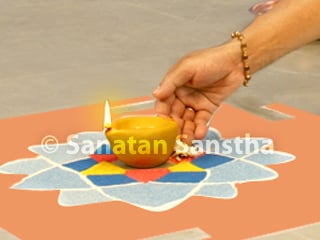
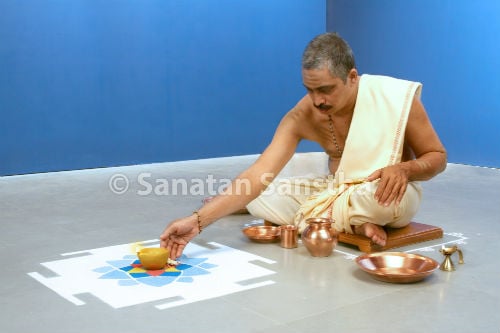
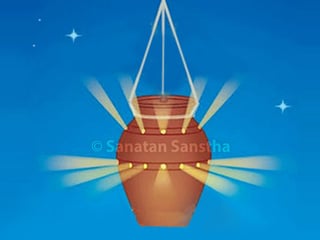 Akash kandil - Diwali Lantern
Akash kandil - Diwali Lantern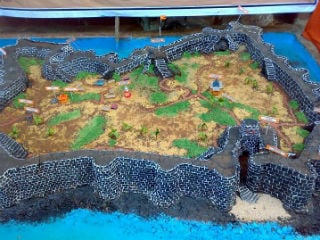 Model forts built during Deepavali awaken ‘Kshatra-vrutti’!
Model forts built during Deepavali awaken ‘Kshatra-vrutti’!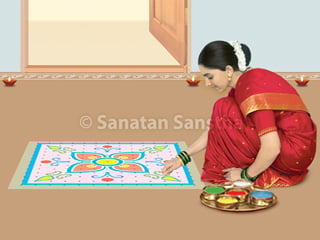 Diwali Festival - Festival of Lights
Diwali Festival - Festival of Lights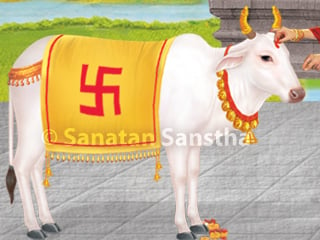 Why Govatsa Dwadashi performed before Deepavali?
Why Govatsa Dwadashi performed before Deepavali?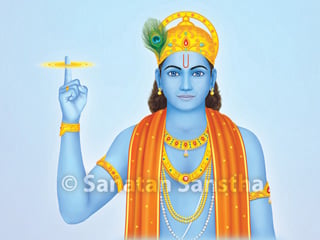 How to celebrate Narak Chaturdashi?
How to celebrate Narak Chaturdashi?